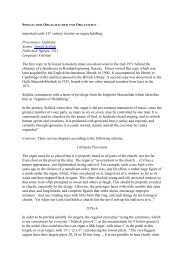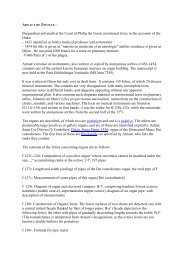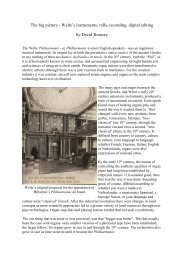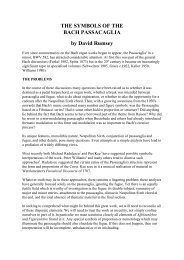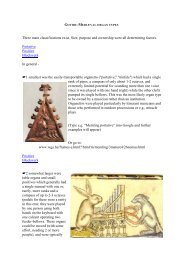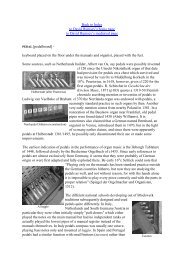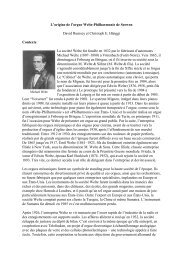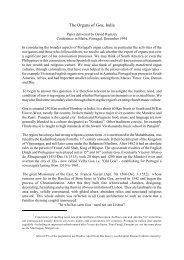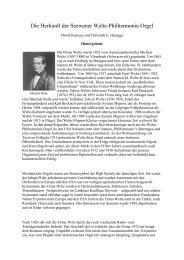Bach and the Holy Trinity - David Rumsey
Bach and the Holy Trinity - David Rumsey
Bach and the Holy Trinity - David Rumsey
Create successful ePaper yourself
Turn your PDF publications into a flip-book with our unique Google optimized e-Paper software.
symbolism that was intended.<br />
8<br />
Thus <strong>the</strong> pre-occupation with Trinitarian concepts in <strong>the</strong> Kyries of Clavierübung Part III<br />
is <strong>the</strong> unavoidable textual reference revealing strong Trinitarian elements. The “large”<br />
settings are momentous pieces of music where <strong>the</strong> first identifies "Kyrie eleison" with<br />
"Gott Vater in Ewigkeit" <strong>and</strong> puts <strong>the</strong> chorale in <strong>the</strong> upper part. The second, “Christe aller<br />
Welt Trost” places <strong>the</strong> chorale in <strong>the</strong> middle of <strong>the</strong> texture as a tenor part. The final<br />
“Kyrie, Gott Heiliger Geist” places its chorale melody deep down in <strong>the</strong> pedal part. Here<br />
we have <strong>Trinity</strong> symbolism at work in both a literary <strong>and</strong> musico-pictorial sense.<br />
A clear basic symbolism is at work here. Where did it originate? One possible answer<br />
may be that, in <strong>the</strong> era immediately preceding <strong>Bach</strong>, <strong>the</strong> Protestant North suppressed<br />
<strong>the</strong>atrical activity, especially Opera <strong>and</strong> its derivatives. For his Leipzig position <strong>Bach</strong> was<br />
expressly forbidden, in his terms of contract article 7, to allow <strong>the</strong> music to become<br />
operatic:<br />
"7. To <strong>the</strong> end that good order may prevail in those churches I should so<br />
arrange <strong>the</strong> music that it may not last too long, <strong>and</strong> also in such wise that<br />
it may not be operatic, but incite <strong>the</strong> hearers to devotion."<br />
In <strong>the</strong> organ music of <strong>the</strong> Protestant North, however, <strong>the</strong>re was a specially dramatic,<br />
th th<br />
almost romantic creativity applied in <strong>the</strong> 17 <strong>and</strong> early 18 centuries. It was as if one<br />
sense had been lost <strong>and</strong> ano<strong>the</strong>r increased to compensate - like a blind person’s improved<br />
perception through hearing <strong>and</strong> touch. One feature of this <strong>the</strong>atrical <strong>and</strong> dramatic organ<br />
style was identified as “stylus phantasticus” - a free, quasi-improvised, style of composing<br />
<strong>and</strong> playing which might be likened to fire <strong>and</strong> brimstone sermonising. One of my<br />
students traced some interesting links between <strong>the</strong> Italian commedia dell’arte <strong>and</strong> North<br />
German stylus phantasticus a few years ago. The outcome of all this was to invest organ<br />
music with a kind of responsibility to represent or symbolise, even bring <strong>the</strong> suppressed<br />
<strong>the</strong>atre right into <strong>the</strong> hallowed precincts of ecclesia. No wonder <strong>the</strong>re grew up to be a<br />
common perception that, if ever <strong>the</strong> devil was going to enter <strong>the</strong> church it would be<br />
through <strong>the</strong> choir loft!<br />
In <strong>the</strong> 18 century art of organ playing <strong>the</strong> practice of playing or improvising organ music<br />
th<br />
to replace a hymn verse where <strong>the</strong> congregation remain silently listening was well<br />
cultivated or forems such as Chorale Fantasia were dedicated to use during communion.<br />
We know from contemporary accounts, as well as <strong>the</strong> music which has survived, that <strong>the</strong><br />
highest examples of this art were expressly destined to interpret <strong>the</strong> <strong>the</strong>ology <strong>and</strong> concepts<br />
of <strong>the</strong> relevant verse, using proper Figur <strong>and</strong> Affekt. And sometimes, it seems,<br />
numerology plays a part in <strong>the</strong> creative <strong>and</strong> symbolic process.



